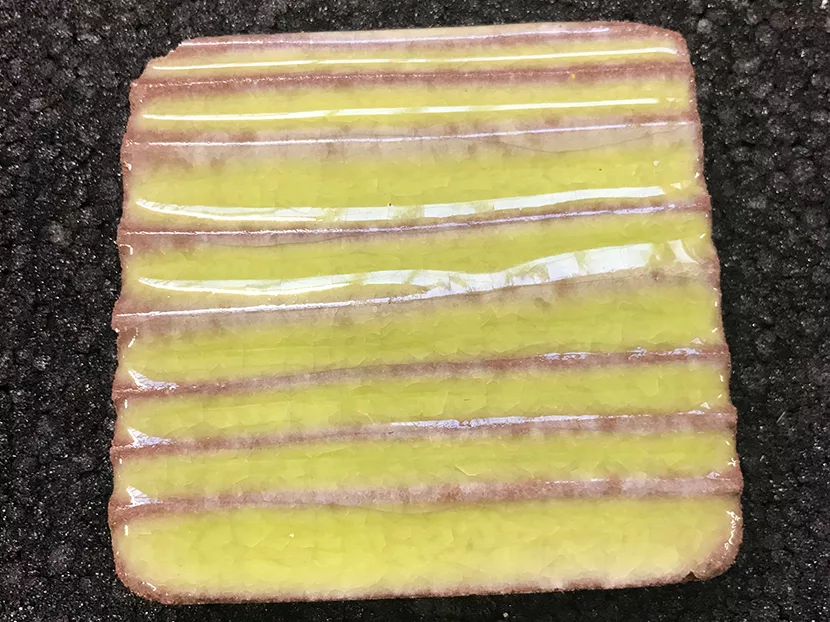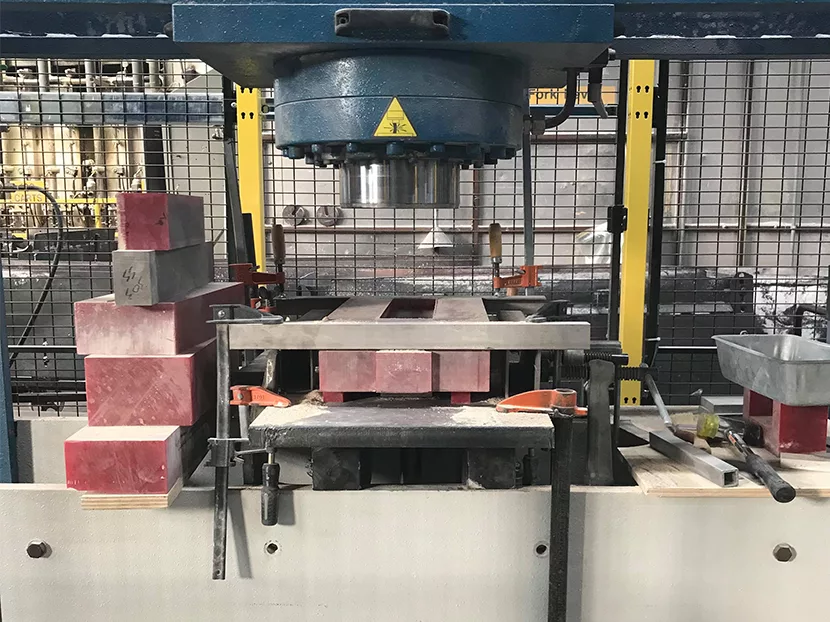"The purpose of art is washing the dust of daily life off our souls."
– Pablo Picasso
While the U.S. produced around 258 million tons of municipal solid waste in 2014, the industrial waste numbers are less clear. Estimates go as high as 7.6 billion tons of industrial waste produced every year. None of us like to think about the waste we generate, but some of those in construction and manufacturing are beginning to.
A high percentage of products and services go to a landfill within a mere six months of being produced. This is something Kohler Co.’s Waste Lab team members had in mind when they started gathering landfill-bound materials from the Sheboygan, Wisconsin location and creating tiles that they plan to sell starting next year under the Ann Sacks decorative tile line.
Piles of dust could inherently be something beautiful. No material was off limits.
In 2015, Waste Lab began by experimenting with broken pieces of toilets and urinals, as well as unfired clay, foundry dust, enamel powder and iron slag.
Project Manager Theresa Millard has been a fundamental driving force and visionary behind Waste Lab. She joined Kohler Co. in 1988, working in the Wisconsin Pottery in technical development. Over the years, she has always strived to locate the point between art and industry.
“We’re looking at the factory as an ecosystem,” Millard explains. “We want to discover ways to harvest each material in a clean way and still allow it to keep its intrinsic value.”
Born in the U.K., Millard is a Certified Biomimicry Professional, holds a Bachelor of Fine Arts degree in ceramics from Wolverhampton Polytechnic, U.K., and a Master of Fine Arts in ceramics from the University of Washington in Seattle.
In 2005, she and her current Waste Lab counterpart, artist Jim Neiman, studied in the Costa Rican rainforest with Janine Benyus and Dayna Baumeister, who invented the framework for the biomimicry methodology, or the imitation of nature’s models that are incorporated into designs and processes that solve human problems. It was then that Millard had an epiphany.
“My job was to design beautiful, high-end things for people to ultimately discard,” she explains. “I met so many insightful people in the biomimicry world who really taught me in a deeper way about ecology. When you stand with biologists and ecologists where life is being born right in front of you and come back to work within an industrial environment, you start to see things you designed, and you wonder ‘what can I do?’”
With this newfound understanding, Millard began to feel the constraints of her role. That is why, two years later, when Kohler Co. created its Kohler environmental leadership team, Millard jumped at the chance to be a part of it.
The idea behind Waste Lab was born in October 2013, during one of Kohler’s Innovation for Good retreats. The Innovation for Good think tank unites associates around the world to discuss sustainable goals and develop solutions to global social problems.
In December 2017, the Waste Lab team officially moved into their new space in Kohler’s cast-iron and enamel factory. The team is making headway in experimenting with materials, making tile and cataloging materials.
“We’ve ended up with little tiles all over, so it’s been helpful to correlate what we’re looking for before we properly categorize the tiles,” Neiman says. “We go through a lot of iterative trials fairly quickly.”
Pete Gross, high school apprentice who was appointed to work with Kohler through Lakeshore Technical College (LTC), is working with the company’s engineering teams and processes until the end of the summer. He works on technical trials and supports the team with record keeping through taking pictures and helping with the documentation of the tiles.
“We’ve been documenting everything we’ve created over the last few weeks.” Millard says. “When working with waste, each piece you work with comes out different. We’re trying to figure out each of their stories and how they work over time.”
It is expected that the tile collections for Kohler’s Ann Sacks line will have a soft launch at the end of 2018, with a full launch at the Kitchen & Bath Show (KBIS) 2019.
The team started out making singular tiles and have quickly ramped up, recently completing their first order for 115 square feet (roughly 460 tiles), which has been installed in the New Product Development office at Kohler.
“The first week, we came out with 10 tiles,” Monty Stauffer, senior industrial designer, said. “The next week it was 30, and we learned some more. Then the next week was 150.”
Stauffer, who has been with Kohler since 2008, has extensive experience as a practicing artist and designer. He is primarily responsible for the development of new materials, products and processes working as a hands-on designer. He and Neiman, who has been sharing his art with Kohler since 1988, have been able to bring their craftsmen eyes and design experience to the tiles. Neiman has played a large role in color development with the company over the years.
“We had a couple of really challenging weeks where we completely went back to zero tiles. Whether color issues or cracking — we missed something,” Neiman says.
Color assessment has a lot to do with the qualification of a tile. One batch of tiles started off as black enamel. The team fired the batch in the kiln and ended up with different shades of green and blue tile. Saturation and placement of the tile in the kiln has a lot to do with the color result.
They have learned this qualification is not a straightforward process, as Senior Project Engineer Josh Boyce points out. Boyce, who has been with Kohler since 2013, has extensive technical experience in material science and ceramic engineering.
“We’re learning how to qualify all the materials and processes we’re working with. We’ve made some wrong assumptions,” Boyce says. “We thought that if we grabbed the material from the cleanest possible collection point, we wouldn’t have to qualify it. But it turns out we do.”
The every-snowflake-is-different tendency of tile is something the team has been trying to understand from a business perspective.
“From a business point of view, we have to think about what the market would accept. If our tiles are different from a person’s color standard, the product might be more difficult to sell. We’re working through these expectations,” Millard says. “Think about organic heirloom tomatoes. Not all of them are going to turn out perfectly round. Some will be square and dented; some will be overripe.”
“These are organic heirloom tiles,” Boyce adds, laughing.
The team has also been trying to work through equipment challenges. The press they are currently working with is used to pressing metal and high production tile — and a lot of it.
“The technology we’re using is normally used for super high engineered parts or high production tiles, and those things are normally made in a precise die that’s really expensive,” Neiman explains. “We’re trying to re-engineer this process to be something that’s flexible with the lowest cost, lowest technology die set we could possibly use, so that we can make a couple of hundred, not a couple of hundred thousand, tiles.”
Working with a machine that is meant to do a specific task that someone wants to use for another task is a delicate art in itself.
“At one point, we broke it…” Stauffer says. “Let me clarify… Jim broke it.”
Stauffer discovered that the top plate of the press had been delaminating the tile, so he made a new one that works better for Waste Lab’s purpose. “This is what we’ve been doing every day – continuous improvement,” he says. “We are finding ways to make our processes better.”
The team has only just begun. As production changes, so will their work in Waste Lab.
“The best thing about starting a new project like this, is that there are so many people here,” Millard says. “Whether, it’s resources, equipment, technology, knowledge and willingness to help, all of this will make our project possible in the end.”
Waste Lab has received help from the Chemical and Metallurgical Laboratory (C&M Lab) in identifying the chemical makeup of each material. It all goes back to what is inherently beautiful.
“I remember looking at something that could have been dust, but someone in the C&M Lab told me, ‘That’s not dust; it’s ceramic,’” Millard says. “C&M has been a great partner in the identification layer of this whole process.”
Waste Lab also worked with Kohler’s architecture team to explore each product and what’s important in spatial design.
Nearly everyone at Kohler who knows about Waste Lab wants to help. “No one says, ‘okay well, I don’t want to be involved with that,’” Boyce says. “It’s getting to the point where we have to keep asking ourselves how can we get everyone who wants to help involved in a meaningful fashion.”
The Waste Lab project stems back to Kohler’s net zero environmental sustainability goals. By 2035, the company aims to eliminate greenhouse emissions and solid waste going to landfills by reducing the quantity of waste materials and finding alternative uses for what remains.
Millard has become a vocal advocate for the reuse work at Kohler. She points to the business and social benefits of an ambitious undertaking like this one.
“We’re preventing materials from going to landfills, providing people with challenging work and raising our consciousness. And there will be approximately 3 billion middle class consumers by 2030 who we think will want things like this. It’s smart business,” she says. “Most importantly, we want to know how we can lift up humanity and provide access to the things the world needs in a better way. Most people want to do good in the world, but they don’t know how. We are trying to be catalysts for change. But we don’t get there without all the collaborators around us. It has to be a systematic change.”









